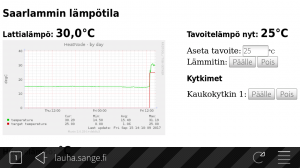I’m very happy to get a change to talk about Puppet in the National Library of Finland. Working with experienced professionals makes an interesting day. I have used their Finto ontology to create one of the largest free Finnish-English dictonaries and enjoyed many services they provide.
Course feedback was very good, 4.4 out of 5. One participant named this as the best course this person had ever participated. Thank you!
 These are some notes and scribbles mentioned in the training. This is not a tutorial on Puppet, just some snippets listed to avoid writing them down manually.
These are some notes and scribbles mentioned in the training. This is not a tutorial on Puppet, just some snippets listed to avoid writing them down manually.
REDACTED This page does not contain all of the course, due to practical reasons and confidentiality. For example, missing are - Theory on Configuration Management Systems - Architectural and practical questions related to National Library network - Security questions related to National Library I still hope that the practical, hands-on commands below are useful.
Key Features of Modern Configuration Management Systems
Idempotent
Infrastructure as Code
Single Source of Truth
Interactive Puppet for Testing and Training
$ sudo apt-get update $ sudo apt-get -y install puppet $ puppet --version
Help and Documentation
Commands print information specific to your version and system. On the web, check the version.
Sudo is usually required with Puppet. Not just for permissions – also the environment will be different.
$ sudo puppet resource file /etc/passwd
file { '/etc/passwd':
ensure => 'file',
content => '{md5}9d892087544105fee8bec3d1d3ad033c',
# ...
}
$ puppet describe file|less
Most important resources: package-file-service, user, exec
$ sudo puppet resource file /tmp/foo ensure=file $ sudo puppet resource file /etc/passwd $ sudo puppet resource file /root/terowashere ensure=file $ sudo puppet resource file /root/terowashere ensure=file content="Moi vaan" $ sudoedit /root/terowashere $ sudo puppet resource package apache2 $ sudo puppet resource package bash $ puppet describe package|less $ sudo puppet resource package apache2 ensure=installed $ curl localhost $ curl localhost -s|grep title $ sudo puppet resource service apache2 ensure=stopped $ sudo puppet resource service apache2 ensure=running enable=true $ sudo puppet resource user vagrant $ sudo puppet resource user terote01 ensure=present managehome=true $ sudo puppet resource user terote01 ensure=absent managehome=true $ sudo puppet resource exec $ puppet describe exec|less $ sudo puppet resource exec 'touch /tmp/ajettu' path='/usr/bin/:' creates="/tmp/ajettu"
Modules
When you create stuff with Puppet, you create modules. One thing fully configured == one module. For example, apache module to install the package with apt , configure it and restart the daemon.
$ cat /etc/puppet/modules/hellotero/manifests/init.pp
class hellotero {
file {"/tmp/hellotero":
content=>"Tero was here\n",
}
}
$ sudo puppet apply -e 'class {hellotero:}'
Notice: Compiled catalog for vagrant.vm in environment production in 0.11 seconds
Notice: /Stage[main]/Hellotero/File[/tmp/hellotero]/ensure: defined content as '{md5}00e10248f6827939f378f0c4c1f0c511'
Notice: Finished catalog run in 0.02 seconds
$ cat /tmp/hellotero
Tero was here
It’s idempotent: the following runs do nothing, as the system has already reached the target state.
$ sudo puppet apply -e 'class {hellotero:}'
$ sudo puppet apply -e 'class {hellotero:}'
Package-File-Service for Apache
Can you improve the module by adding the missing requires?
Notice the weird syntax inside template(“apache/teroexamplecom.conf”): module/filename. It’s not a path. It does not contain the word “template”.
Two files, some directories:
$ find /etc/puppet/modules/apache/ /etc/puppet/modules/apache/ /etc/puppet/modules/apache/manifests /etc/puppet/modules/apache/manifests/init.pp /etc/puppet/modules/apache/templates /etc/puppet/modules/apache/templates/teroexamplecom.conf
/etc/puppet/modules/apache/manifests/init.pp
class apache {
package {"apache2":
ensure => "installed",
}
file {"/var/www/html/index.html":
content=>"Welcome\n",
}
file {"/etc/apache2/sites-available/teroexamplecom.conf":
content=>template("apache/teroexamplecom.conf"),
notify=>Service["apache2"],
}
file {"/etc/apache2/sites-enabled/teroexamplecom.conf":
ensure=>"symlink",
target=>"../sites-available/teroexamplecom.conf",
notify=>Service["apache2"],
}
file {"/etc/apache2/sites-enabled/000-default.conf":
ensure=>'absent',
notify=>Service["apache2"],
}
service {"apache2":
ensure=>"running",
enable=>"true",
require=>Package["apache2"],
}
}
/etc/puppet/modules/apache/templates/teroexamplecom.conf
<VirtualHost *:80> ServerName tero.example.com ServerAlias www.tero.example.com DocumentRoot /home/vagrant/public_html/ <Directory /home/vagrant/public_html> Require all granted </Directory> </VirtualHost>
Testing
$ sudo puppet apply -e 'class {apache:}'
If you create the file mentioned in the new virtual host definition, you can test it.
$ curl localhost See you at TeroKarvinen.co
Can you write a similar module to configure sshd to an alternate port?
Tricks
Short prompt
$ export PS1="\W\$ "
Parametrized Classes, Variables and Templates
vagrant@vagrant:~$ cat notes2.txt
vagrant@vagrant:/etc/puppet/modules/paramet$ cat manifests/init.pp
class paramet($port=80) {
notice("Port is ${port}.")
file {"/tmp/hello.txt":
content => template("paramet/hello.txt.erb")
}
}
vagrant@vagrant:/etc/puppet/modules/paramet$ cat templates/hello.txt.erb
Hello Tero
The port is <%= @port %>
This system is <%= @lsbdistdescription %>
vagrant@vagrant:/etc/puppet/modules/paramet$ sudo puppet apply -e 'class {paramet: port=>73}'
Notice: Scope(Class[Paramet]): Port is 73.
Notice: Compiled catalog for vagrant.vm in environment production in 0.13 seconds
Notice: Finished catalog run in 0.08 seconds
vagrant@vagrant:/etc/puppet/modules/paramet$ cat /tmp/hello.txt
Hello Tero
The port is 73
This system is Ubuntu 16.04.3 LTS
Site Manifests
$ cat /etc/puppet/manifests/site.pp
class {paramet: port=>73}
class {apache:}
class {hellotero:}
$ sudo puppet apply /etc/puppet/manifests/site.pp
Notice: Scope(Class[Paramet]): Port is 73.
Notice: Compiled catalog for vagrant.vm in environment production in 0.68 seconds
Notice: /Stage[main]/Hellotero/File[/tmp/hellotero]/ensure: defined content as '{md5}00e10248f6827939f378f0c4c1f0c511'
Notice: /Stage[main]/Paramet/File[/tmp/hello.txt]/ensure: defined content as '{md5}53524a1710272973551edb515715a8fd'
Notice: Finished catalog run in 0.06 seconds
Master and Slave
$ sudo apt-get -y install puppetmaster $ sudo puppet agent --enable
$ sudo puppet agent --test
$ sudo puppet agent --test --debug --verbose $ sudoedit /etc/hosts # test only, 127.0.0.1 puppet
For Master and Slave on different computers
$ sudoedit /etc/puppet/puppet.conf
Add DNS names under [master] heading
dns_alt_names = puppet, master.local, puppet.terokarvinen.com
For slave
$ sudoedit /etc/puppet/puppet.conf
[agent] server = tmaster.example.com
Fixing Cert Problems
Master is the most valuable computer in the network it protects. That’s why Puppet errs on the side of not working when certs don’t match or validate.
$ sudo service puppetmaster stop $ sudo rm -r /var/lib/puppet/ssl
$ sudo service puppet stop $ sudo rm -r /var/lib/puppet/ssl
Conditional Statements
Make your module work on one platform first. Add conditional logic in the beginning.
class apache {
if $operatingsystem == "Ubuntu" {
$webserver = "apache2"
} else {
$webserver = "httpd"
}
notice("webserver is ${webserver}")
####
package {"apache2":
name => "${webserver}",
ensure => "installed",
}
# ...
}
Git Version Control
With Git, use only what you need, and what everyone on you team can use.
Basic use
$ git init $ nano README $ git add . && git commit
Helful commands
$ git log $ git status
Network use
$ git clone https://github.com/hattupuu/earplotter.git $ cd earplotter/
$ git add . && git commit; git pull && git push
Pull first. Always pull before push.
Read More
Tag Puppet on TeroKarvinen.com
Awaseroot A finished project by my students.
Arctic CCM My students just started the project, there will be new content weekly.
Puppet Reading List Including how US GOV and Wikipedia use Puppet.
An Interesting System
Adminstrivia
This article will be updated as more notes are being scribbled.



Testaan pupettia mahdollisesti raspien konffimiseen.
Opin hyvin puppetin perusteet ja sain riittävät eväät siihen, että pystyn itseänäisesti jatkamaan puppettiin tutustumista. Kurssi oli minulle erittäin hyödyllinen.
Kurssilla opittuja asioita on tarkoitus käyttää palvelinylläpidon tehostamiseen. Suosittelisin kurssia ystäville ja kollegoilleni.
Did I learn something?
– Yes, I know understand Puppet. 🙂
Is it usefull for me?
– Yes.
How do I plan to use my skills after the course?
– At least to administrate our servers.
How could the course be improved?
– No idea. 🙂
Would I recommend this course to my friends or collegues?
– Yes, absolutely!